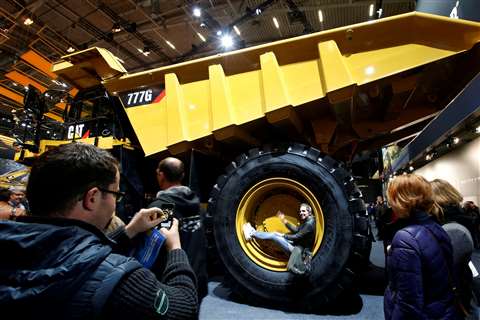What are construction R&D teams working on?
02 September 2022
The clamour for productivity gains and reduced emissions is driving growth in R&D investment, as Mike Hayes reports.
It has long been understood that research and development (R&D) activity contributes to a company’s competitiveness and can generate significant added value to products.
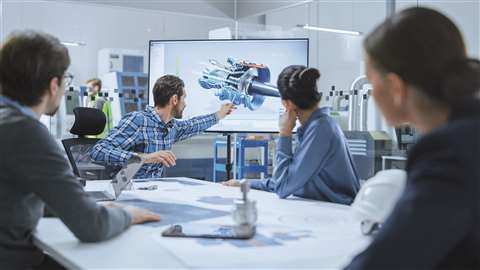 Construction firms are investing heavily in R&D. (Photo: Adobe Stock)
Construction firms are investing heavily in R&D. (Photo: Adobe Stock)
In terms of construction, governments and policy makers the world over agree that building a stronger innovation culture within the industry will result in much-needed productivity gains.
Whether or not claims of poor R&D investment in the industry are accurate, it’s fair to say we are seeing a significant increase in the number of new and innovative construction products and machines coming to market.
With the Bauma Munich construction equipment exhibition taking place in October, R&D teams around the world will have been working overtime, with the aim of delivering eye-catching innovations.
Yet businesses delivering products and machinery to construction have been increasingly turning their budgets towards R&D for years, looking to deliver increased efficiency to customers who are seeing margins squeezed, in a sector historically marked by a distinct lack of productivity progress.
It is hoped that the new innovations being brought to market will have the multiplier effect – boosting profits for early adopters, making them more attractive to talented jobseekers and reducing their carbon emissions. No pressure then…
What are the different alternative fuels?
At this year’s Bauma the largest single exhibitor will be Liebherr. The company has traditionally seen the fair as an opportunity to gauge reactions to its latest technologies and machines, and this year’s event is no different.
In 2021, Liebherr invested €559 million (US$568 million) in R&D, with the majority of it used in the development of new products – the two focal points being alternative drive technologies and digitalisation.
Advances in technology are inextricably linked with sustainability and, in terms of equipment, perhaps none more so than alternatives to diesel power.
Liebherr says it is following a technology neutral approach to its power research. It is, for example, working on hydrogen-powered combustion engines and their injection technologies, plus electric drives and hybrid drives, as well as examining the use of alternative fuels.
This approach jibes with a study conducted by Frontier Economics, which showed that, in construction machinery, the greatest reductions in emissions can be made if the entire lifecycle of a product is considered.
At Bauma, Liebherr will show battery-powered piling/drilling rigs and crawler cranes, as well as its new mobile energy storage system, Liduro Power Port.
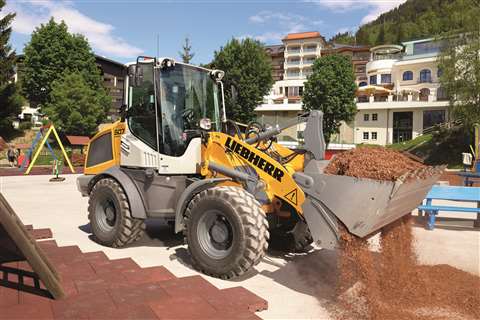 Liebherr says its R&D is focused on alterative drive technologies and digitisation. (Photo: Liebherr)
Liebherr says its R&D is focused on alterative drive technologies and digitisation. (Photo: Liebherr)
Besides electrification, Liebherr will show its H2 direct injection – using hydrogen as a fuel to power internal combustion engines – as well as applications for emission-reducing fuels like HVO (Hydrotreated Vegetable Oil).
Hydrogen powered construction machines
Hyundai CE’s R&D focus is similarly based on a combination of advanced tech and eco-friendly innovations.
While recognising the importance of the development of electric power in construction equipment, the company is acutely aware of the growing importance of hydrogen.
Gert Peeters, product manager at Hyundai CE Europe, says, “While great progress has already been made in the development of electric vehicle technology, there is a risk that we overlook hydrogen as a practical, immediate solution to reduce emissions and improve air quality.
“Our projections show that fuel-powered vehicles will be more cost-effective than battery-electric or diesel-powered vehicles in the future. We are convinced that hydrogen will be at the forefront of renewable energies in the long term.
“We want to exploit this potential and make it available to users in practice-oriented solutions.”
To this end, Hyundai has produced the 14 tonne HW155H concept wheeled excavator, powered by a hydrogen fuel cell, which has been jointly developed by Hyundai CE, Hyundai Motors and Hyundai Mobis at its Mabuk Research Centre in Korea.
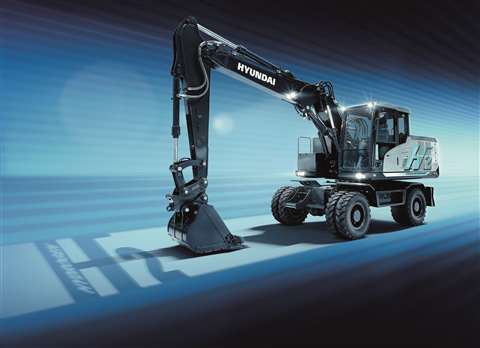 The 14 tonne HW155H concept wheeled excavator from Hyundai CE emits nothing but water. (Photo: Hyundai CE)
The 14 tonne HW155H concept wheeled excavator from Hyundai CE emits nothing but water. (Photo: Hyundai CE)
The company says its Hyundai Connect brand has been created as an umbrella for the company’s advanced and smart technologies and is producing solutions for, “Effective equipment management based on ICT and future eco-friendly energy solutions, including electric and hydrogen fuel cells for construction machinery.”
Hyundai’s Hi Site offers an overview of a complete construction project, creating smart construction techniques in surveying and planning. This involves the use of drone surveying, site digitisation and analysis.
What is the future of construction equipment?
At Swedish mining and construction tools specialist Epiroc, the strategic focus is on balancing immediate customer needs with the desire to incorporate advanced technology.
Erik Sigfridsson, VP of R&D at Epiroc’s Tools & Attachments division, recognises that advances in electrification and automation are key to the future of construction, but feels the nature of Epiroc’s products give the company a slightly different perspective.
He says, “We believe that electronic control will play an important role in the near future – more intelligent and efficient attachments together with connectivity and digital services that comes with the connectivity.
“We started that journey some time back with the HATCON device that delivers product intelligence through our MyEpiroc app. We believe this will be an important support and will bring even more customer value as devices, sensors and data transfer will become more developed.”
Sigfridsson believes development is never ‘done’ and opportunities to improve are continually presenting themselves.
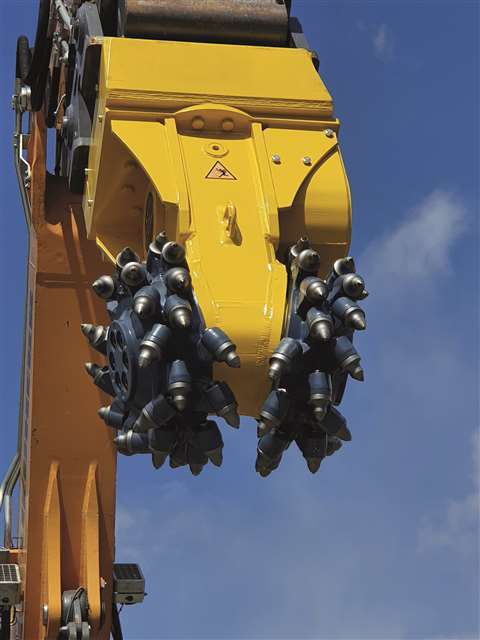 Epiroc will bring a new version of its V Cutters to Bauma, a V-shaped drum cutter for trenching. (Photo: Epiroc)
Epiroc will bring a new version of its V Cutters to Bauma, a V-shaped drum cutter for trenching. (Photo: Epiroc)
“A good recent example,” he says, “is the V Cutters, a V-shaped drum cutter for trenching and many more applications. Here we created another industry first that saves time, energy and investment cost for our customers.
“It is clearly a new innovative design fully in line with our ambition to be the market innovator.
Rickard Hammer, global products R&D manager at Epiroc, gives an indication of the many steps to be taken before a new product reaches the market, saying, “Product verifications are performed to verify the safety of the product and conformity with the set product specification including legal and environmental requirements.
“The verifications can be made for instance by inspections, calculations, tests, simulations, or reviews.
“Final validation is most often done through a field test together with customers, and aims at establishing the reliability, serviceability, productivity, operating costs, etc, of the product under actual field conditions.
“Failure reports and reliability field data from the field is analysed for continuous improvement of already released products. As customers are providing data, they are also securing that future generations of the product are further improved.”
How can construction be environmentally friendly?
Komatsu has a razor-sharp focus on emissions, with many of its technological advances based on its drive towards carbon neutrality.
Komatsu’s SEO, CTO, and president of the development division, Seiichi Fuchita, says “Under the new mid-term management plan (FY2022 – 2024), Komatsu has defined the targets of reducing CO2 emissions by 50%, raising the ratio of renewable energy use to 50% by 2030 from 2010 levels.”
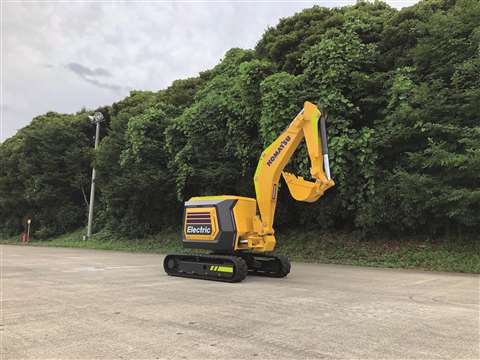 Komatsu’s fully-electric, remote-controlled concept excavator is designed with no hydraulics. (Photo: Komatsu)
Komatsu’s fully-electric, remote-controlled concept excavator is designed with no hydraulics. (Photo: Komatsu)
With this in mind, he says the company has “made consistent efforts to reduce fuel consumption and improve efficiency. Going forward, however, it will be important to augment these efforts by working to electrify and automate equipment.
“Komatsu has already had success in developing equipment with reduced environmental impacts, including mid-sized hybrid hydraulic excavators and diesel–electric super-large wheel loaders and dump trucks, and we look to further build upon these technologies going forward.”
Also, in May last year, the company unveiled a fully-remote-control, fully-electric mini excavator, with electric cylinders that utilise no hydraulics. The 3 tonne machine will be exhibited at Bauma this year and Seiichi Fuchita says, “Komatsu will strive to create new value, with the accelerated development and market introduction of electrified machinery.”
Benefits of a connected construction site
As a technology provider for the construction industry, one would imagine R&D is pretty much the heart and soul of Trimble. Aviad Almagor, VP of Technology Innovation, says that a connected construction work environment is a major R&D focus for the company.
“Our goal is to improve efficiency, quality, sustainability, and safety by streamlining communication and collaboration throughout the construction lifecycle. Integrated systems, data-driven workflows, situational intelligence, and automated processes are critical enablers in the industry’s digital transformation journey and are a big focus for us.”
Trimble says a focus for its R&D is to advance digital solutions that can support and augment human construction work. Almagor describes “spanning the full industry continuum from conceptual design to project management and rugged, field-proven hardware to execute projects.”
To this end, Trimble also works closely with manufacturers to drive the development of on-board solutions for construction equipment.
“Autonomy is a top priority for us,” says Almagor, “but it’s important to note that we are focused on automating workflows and processes across the construction continuum – not just machines. This includes the evolution from digital construction to data-driven construction and automated processes.”
STAY CONNECTED



Receive the information you need when you need it through our world-leading magazines, newsletters and daily briefings.
CONNECT WITH THE TEAM









